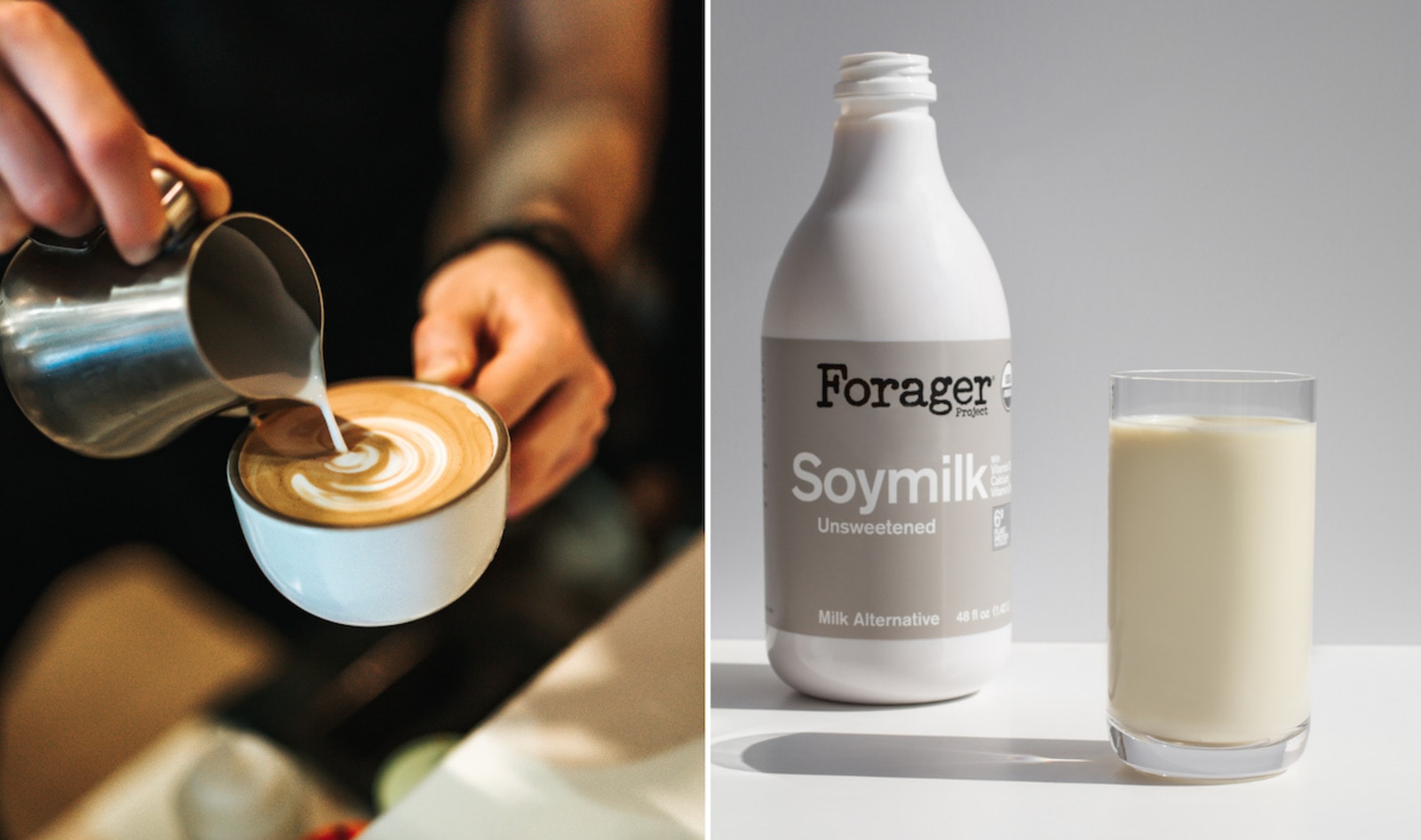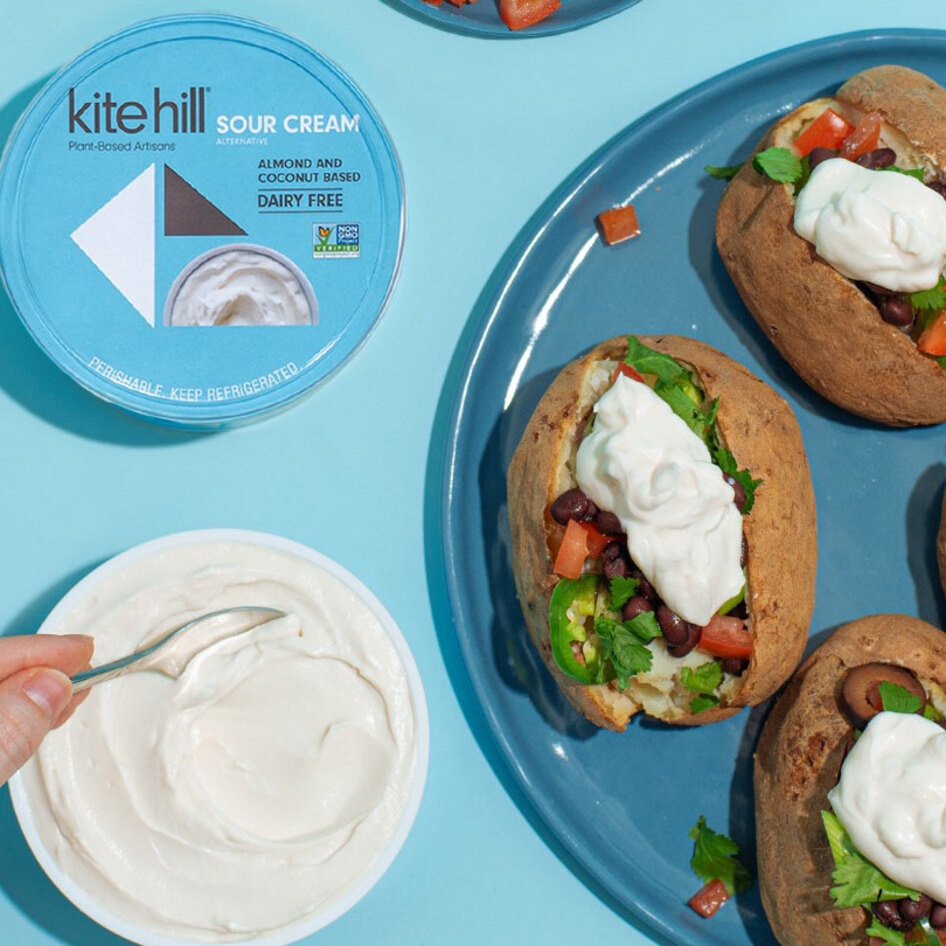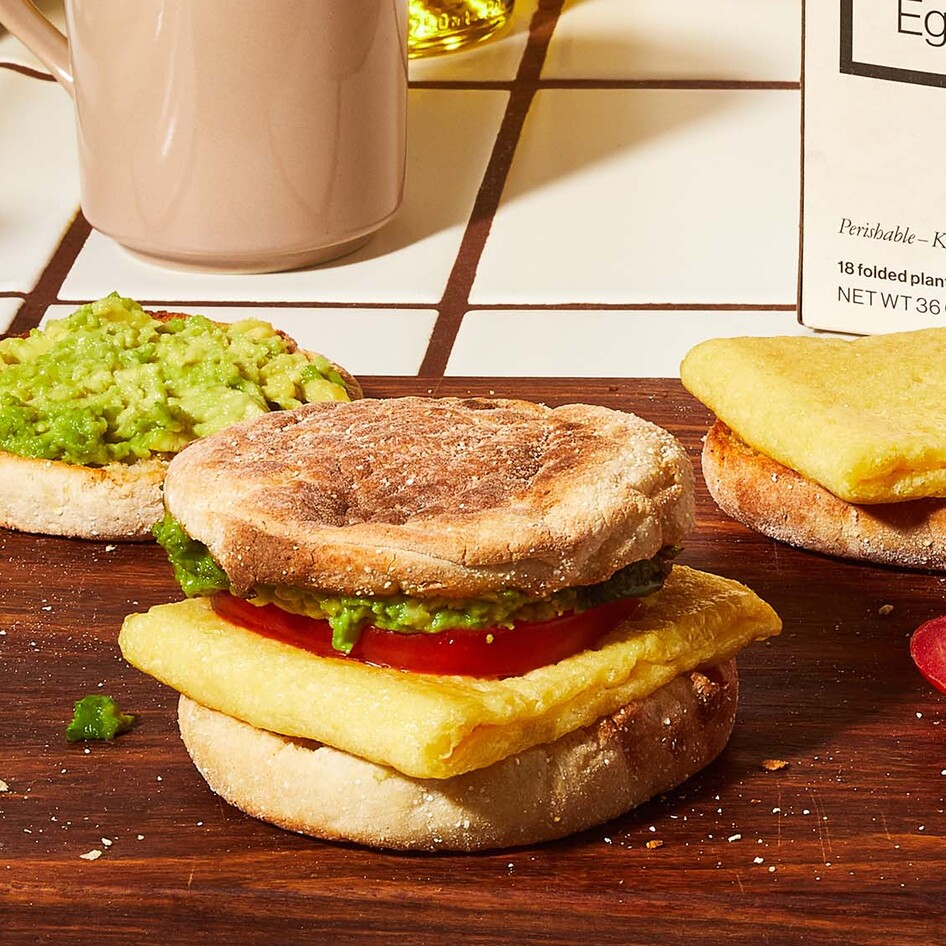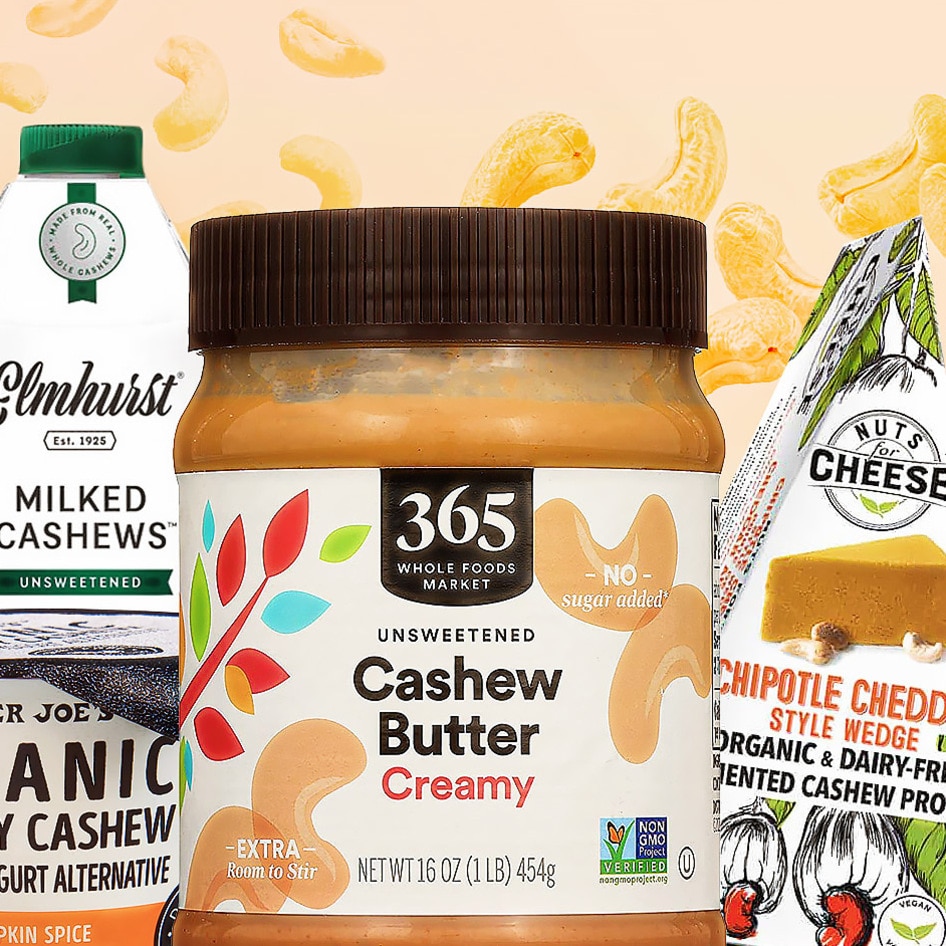In an age where oat and pea milk are on the rise and animal-free whey is sold in the form of ice cream at supermarkets for $4.99, one vegan dairy company decided to take a step back. In September, Forager Project launched its first organic soy milk beverage—triggering major whiplash in an industry that’s all but left soy behind. Some coffee shops are slashing soy milk from their menus in favor of oat, pea, almond, or homemade cashew milk, and vegan meat companies are turning to pea and wheat proteins to produce their burgers, sausages, and chicken nuggets. But soy is making a comeback. We spoke with Forager Project—along with several other soy-positive brands—to learn more about the benefits of soy in regards to health and creating stellar vegan products.
“We just felt it was time to give soy its proper limelight as we think it still is one of the best plant-based superfood sources of protein, vitamins, and nutrients and is sustainably grown.”
— Stephen Williamson
Is soy healthy?
Let’s address the 1,000-pound block of tofu in the room—will soy give you cancer? Will it cause instant man boobs? No. As long as you’re not consuming three quarts of soy milk a day (as was the case with the man who actually did develop gynecomastia, or fatty breast tissue), you should be in the clear. While abated to an extent, the fear surrounding soy has lingered due to a gross miscommunication. Soy contains phytoestrogens which are plant-based compounds that are similar—but not exact replicas—of human estrogen. Unlike animal-based estrogen and other hormones, phytoestrogens do not throw your hormones off balance. In fact, phytoestrogens can help manage the total estrogen in one’s body by attaching to estrogen receptors and blocking excess estrogen from interacting with the cells. This unique characteristic may actually inhibit the cancerous effect of excess estrogen, according to Dr. Christian Gonzalez, ND.
Far from causing any adverse health effects, soy—in its non-isolated, whole form—is a nutritional powerhouse. In a historic decision, the USDA’s 2020–2025 Dietary Guidelines for Americans now states that fortified soy milk is a nutritionally equivalent alternative to cow’s milk. While the dairy food group still plays a prominent role within the guidelines’ recommendations, that single line is a monumental step forward for the USDA which had yet to recommend any non-dairy option for those unable or unwilling to consume milk from an animal. Soy milk naturally contains 8 grams of complete protein—the same amount per 8-ounce serving as cow’s milk—and fortified options also contain about 30 percent of the recommended daily amount (RDA) of calcium and 15 percent of the RDA of vitamin D. These three nutrients—protein, calcium, and vitamin D—are responsible for putting cow’s milk on a pedestal and giving it its own food group. Well, soy can match milk’s nutritional profile. In fact, it can outperform it. In addition to these highly touted essential micro and macronutrients, soy milk also contains antioxidants—compounds that fight free radicals in the body and counter chronic and acute inflammation. It also is very low in saturated fat (about 0.5 grams per serving), moderate in gut-healthy fiber (cow’s milk is devoid of fiber), and free from artery-clogging cholesterol. Soy milk won’t give you cancer, but it certainly will provide a nutritional boost.
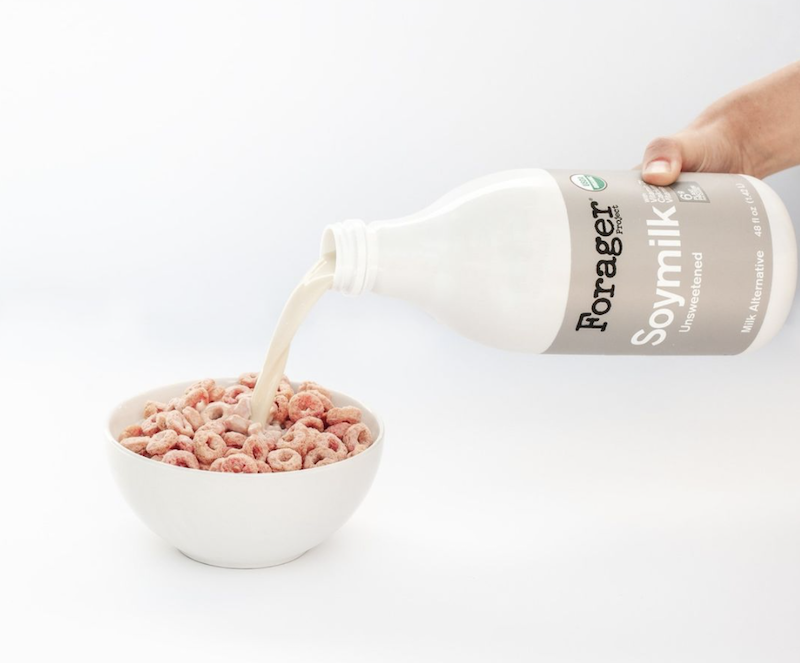 Forager Project
Forager Project
Forager is bringing soy back
Originally dedicated to the versatile and creamy cashew, Forager Project never rejected soy outright—it just really fell in love with this crescent-shaped nut. So why the unorthodox soy milk launch? “We just felt it was time to give soy its proper limelight as we think it still is one of the best plant-based superfood sources of protein, vitamins, and nutrients and is sustainably grown,” Stephen Williamson, Forager Project co-founder and CEO, explained.
“Many have forgotten about the benefits of soy. Soy’s benefits have been clouded by nutrition stigmas that are not based in facts, and we felt we could offer a great-tasting, nutrient-dense soy milk with clean, simple, whole ingredients,” Williamson continued.
There’s no arguing that Forager Project’s cashew-based milks and yogurts are super creamy, but Williamson promised that the new soy beverage will be even closer to the texture of cow-based dairy. However, the brand simply couldn’t stay away from its beloved cashews. While soy is the main ingredient, Forager Project’s soy milk also contains cashews and coconut cream, along with a bit of oat flour to round out the smooth finish. Those curious enough to look at the nutrition label will notice that this product has slightly less protein than straight soy milk—6 grams opposed to 8—due to the addition of these ingredients. However, like many plant-based beverages today, Forager Project’s soy beverage is fortified with essential vitamins such as vitamin D, calcium, and that ever-illusive vitamin B12.
Considering Forager Project’s range, we tried to get Williamson to unveil future products (ice cream? yogurt?) also featuring soy. Alas, his coy response was “You will have to stay tuned to find out!”
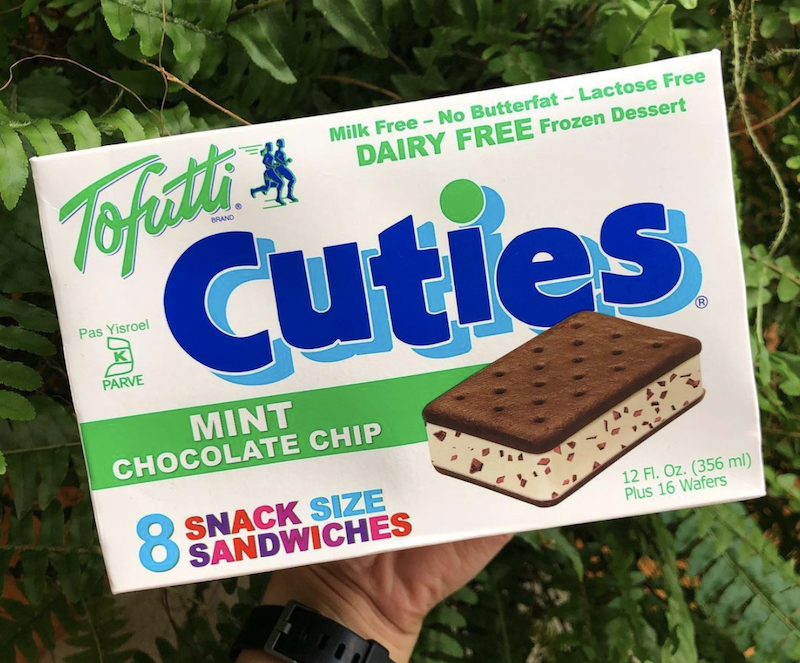 @Chickpeaexpress/Instagram
@Chickpeaexpress/Instagram
The Tofutti legacy
While Forager Project is new to soy as an ingredient, long-standing companies such as Tofutti and Lightlife have relied on soy to produce a majority (if not all, in the case of Tofutti) of their products. VegNews interviewed representatives from both brands to discover why soy is their building block of choice.
“Google ‘vegan cheesecake’ and see all the recipes that come up using Tofutti Better Than Cream Cheese,” Gerry Pugliese, Marketing and Public Relations Manager for Tofutti, challenged. The brand has relied on soy as its prime ingredient since its inception in 1981, and Pugliese stressed that soy is still firmly a part of the plant-based lifestyle. He explained that Tofutti’s research and development team chose soy when creating its inaugural product—Tofutti Better Than Cream Cheese—because of the food’s versatility and ability to take on flavors. “Soy adds substance without interfering with taste,” he elucidated. Soy has served the brand well—appearing in everything from the cult-favorite Tofutti Cuties ice cream sandwiches to the cream cheese to the more recent dips.
“Google ‘vegan cheesecake’ and see all the recipes that come up using Tofutti Better Than Cream Cheese.”
— Gerry Pugliese
Tofutti has its eye on recent trends, but with “tofu” in its name, it’s sticking to what it knows best. One of the marvelous successes about Tofutti products is that unlike some soy-based products that are less-than-appetizing, Tofutti has managed to nail both taste and texture and stay alive in the ever more competitive plant-based market space.
“A lot of Tofutti’s success—especially with our Cuties—is that Tofutti was the first to do it,” Pugliese explained. “That’s 40 years of reputation building, fueling brand loyalty over generations. Customers say that our products don’t have the aftertaste that some of our competitors’ products have. That might be the biggest part of Tofutti’s success. You don’t need to accept inferior taste; it still tastes like you’re enjoying dairy. No sacrifice.”
How does Pugliese enjoy his Tofutti cream cheese? “A hunk of diner-style cheesecake made with Tofutti cream cheese and a cup of black coffee—cue Journey’s ‘Don’t Stop Believin—’is where it’s at,” he said.
Want to take a cue from Pugliese and listen to Journey as you scarf down a vegan cheesecake? Check out this Vegan New York-Style Cheesecake recipe to get the ball rolling.
 Donal Skehan
Donal Skehan
Lightlife on soy, tempeh, and Smart Dogs
Those who have been around since 1979 may know this best-selling tempeh brand by another name: Tempeh Works. For the first five years of business, Lightlife was focused exclusively on tempeh—a fermented soy product that’s even less processed than tofu. While the brand has experimented with alternative proteins—such as pea—for its more recent burger and sausage SKUs, the company born from soy has stuck firmly to its roots.
“Soy is high in protein, versatile for cooking, and less processed than many plant-based protein alternatives,” a Lightlife representative explained. “It also maintains a firm texture and can be baked, fried, steamed, or grilled, and it easily absorbs marinades, spices, and sauces.”
Essentially, it’s not the Smart Dog itself that takes us back to childhood barbecues and pool days—it’s the accoutrements that count. The brand offered up some incredible iterations of the classic hot dog such as the adorably Mini Mac and Cheese Smart Dogs and California-cool Avocado Toast Smart Dogs.
In regards to the polarizing issue of GMO soy, working with the non-GMO Project is essential for Lightlife whenever sourcing soy-based ingredients. Its regulations for tempeh products are even higher—all Lightlife tempeh is certified organic. While the altercation surrounding soy, man boobs, and cancer has been put to rest, the issues surrounding genetically modified organisms in food still loom large. Companies like Lightlife and Forager err on the side of caution by utilizing non-GMO or organic soy.
The best uses for soy milk
Soy milk is one of the few plant milks that can truly do it all. Thanks to its robust nutritional profile and solid amount of protein and fat, it can stand up to heat—making it an ideal choice for baking and steaming. If it’s been a while since you’ve had a carton of soy milk on hand, here are a few applications where this plant milk really shines.
“Soy is high in protein, versatile for cooking, and less processed than many plant-based protein alternatives. It also maintains a firm texture and can be baked, fried, steamed, or grilled, and it easily absorbs marinades, spices, and sauces.”
— Lightlife representative
Lattes and espresso beverages
Soy milk froths like a boss. While low in saturated fat, its unsaturated fat content allows the milk to stay together—not curdle—when steamed or poured into hot coffee. Unlike other non-dairy milks such as almond, coconut, or cashew, soy milk is stable under pressure. In our collective experience of sampling thousands of soy milk lattes, we’ve found that Pacific Foods Barista (the one with the green top) makes for the most delicate microfoam and perfectly balanced cappuccino, cortado, and latte.
Baking
A plethora of vegan cake, pancake, and other baked goods recipes call for adding apple cider vinegar to plant milk and allowing it to curdle. Essentially vegan buttermilk, this simple science experiment adds essential moisture and lift to any sweet. Some non-dairy milks don’t react as well as soy milk, which is why we recommend going for the good stuff when it comes to vegan cake.
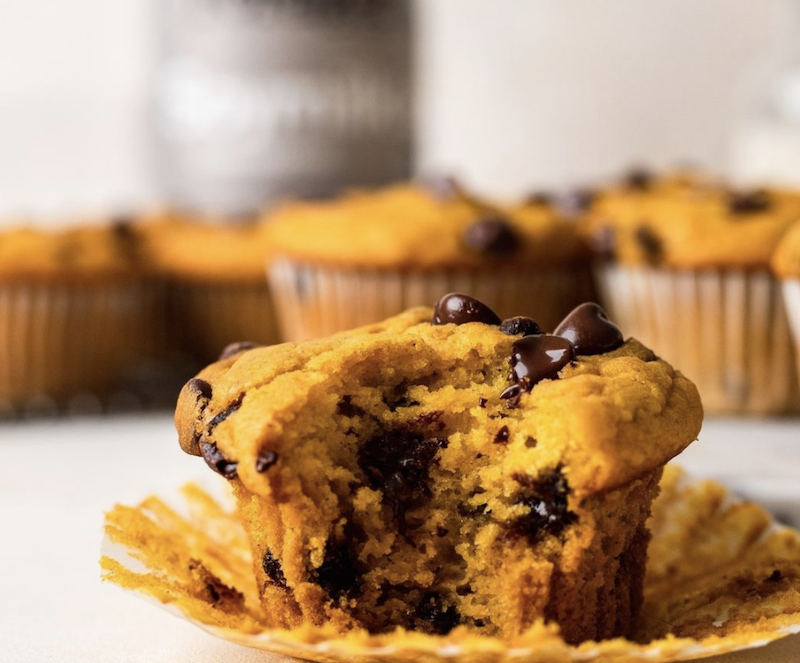 Forager Project
Forager Project
Straight from the glass
Particularly for kids who are used to drinking milk by the glass or drowning a bowl of cereal, swapping cow’s milk for soy milk is an easy way to keep the nutrition and taste of dairy without taking in any of its negative side effects. You may want to look for a lightly sweetened or flavored variety—like Silk Vanilla—if you’re new to the taste of soy. Chocolate soy milk is also a solid replacement for chocolate milk.
Smoothies
To ensure your post-workout smoothie or pre-meeting shake actually contains enough protein to allow your muscles to recover and enable your body to power through, opt for soy milk. With eight grams of protein per cup, you’ll get a nutritional boost in addition to all the antioxidants and good carbs found in your spinach-packed fruit smoothie. Try using soy in this Chocolaty Vegan Peanut Butter Smoothie Bowl after an intense lifting session.
Cooking
We’re talking bechamel sauces, rouxs, and creamy mother sauces that involve heating equal parts flour and butter followed by a pour of milk. These elemental culinary sauces are used to make gravy, cheese sauces, and decadent fillings for pot pies and casseroles. While other milks may break or curdle, soy milk stands up to the heat. Make sure you have soy milk on hand the next time you make a vegan mac and cheese, alfredo sauce, or mushroom gravy.
For more about soy and non-dairy milk, read:
Is Milk Bad for You? The Truth About Dairy
Dear Men: Eating Soy (or Impossible Whoppers) Won’t Give You Man Boobs
What Is Tofu, Exactly? Plus, the 7 Best Ways to Use It
JUMP TO ... Latest News | Recipes | Guides | Health | Shop

